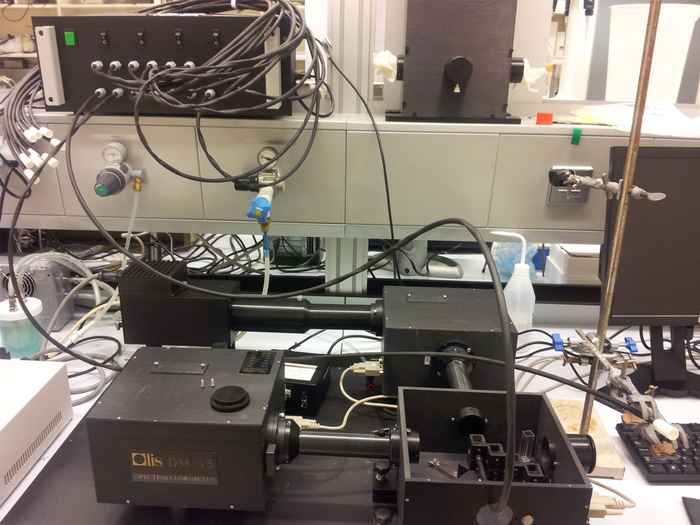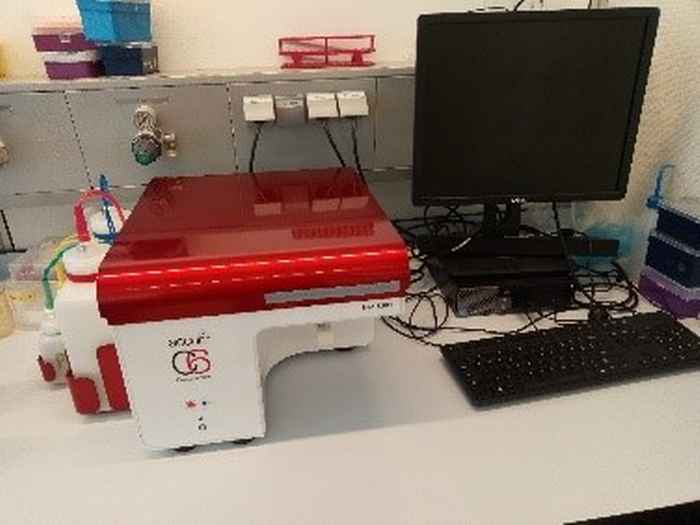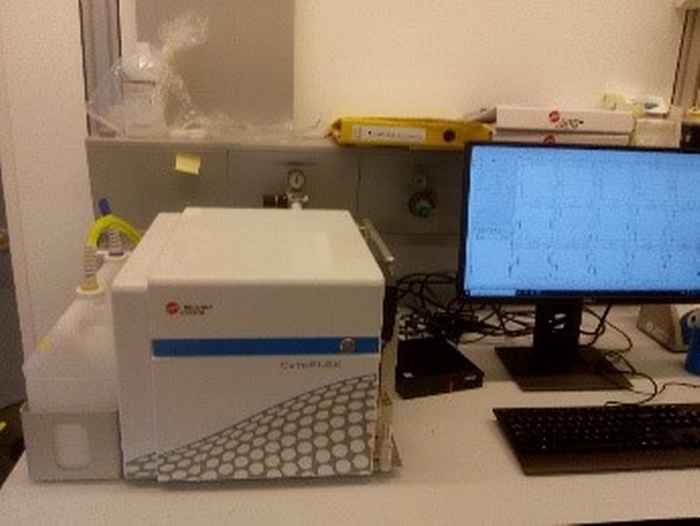Fluorimetry

OLIS DM45 Spectrofluorimetry
The DM45 spectrofluorimeter from OLIS is a great tool for measuring fluorescence . The DM45 includes two single grafting monochromators, an easy to light 150W xenon arc lamp and a high sensitivity photon counting detector with a spectral range of 250-800 nm. Our DM45 is equipped with two cuvette sample chambers. The DM45 multicell cuvette chamber can be used for room temperature fluorescence measurements and can hold up to 4 samples at the same time. The DM45 single cuvette holder can be used for low temperature (77K) fluorescence. The sample chamber is filled with liquid nitrogen in which the cuvette holder is lowered. A typical applications in our lab is the quantification of photosystem ratios and relative pigment content
-
Technical information
- OLIS DM45 spectrofluorimeter
- 150W Xenon arc lamp
- Photon counter optimised for spectral ranges from 250-800 nm
- Multicell cuvette chamber for room temperature fluorescence
- Cuvette chamber for liquid nitrogen with 3 cuvette holders for low temperature (77K) fluorescence.

PAM Fluorimetry
Our institute has a long history in assessing photosyntitic activity of autotrophic aquatic organisms like plantonic algea, microphytobenthos and macrophytes. We use PAM fluorimetry to provide a fast assessment of the overall photosynthetic state through comparison of photosynthetic rates based on fluorescence. Specifically, the measurement of fluorescence is often used as an indicator of the early effects of stress on autotrophic organisms caused by varying environmental conditions. PAM fluorometers allow rapid assessment of photosynthetic energy conversion, wherever this takes place in the field or laboratory.
-
Technical information
Water-PAM/F, Diving-PAM, Phyto-PAM and Mini-PAM (Walz, Effeltrich, Germany)
We own a variety of PAM fluorometers:

Mini-PAM. Photo: IBED - The optical sensor of our water-PAM/F is connected to a robot arm and can be used for repetitive measurements of for instance 96 wells plates or sediment cores.
- The DIVING-PAM underwater fluorometer is suitable for studying in situ photosynthesis of underwater plants, including sea grasses, macroalgae, and zooxanthellae in corals.
- The Phyto-PAM is used to quantify the presence of different algae groups based on differences in absorption spectra.
- Mini-PAM is suitable for basic PAM applications.

Flow Cytometer
The Flow Cytometry is a laser-based, biophysical technology employed in cell counting, cell sorting, biomarker detection and protein engineering, by suspending cells in a stream of fluid and passing them by an electronic detection apparatus. It allows simultaneous multiparametric analysis of the physical and chemical characteristics of up to thousands of particles per second. In our studies Flow cytometry used to quantify bacteria (using dyes) and to distinguish an quantify different species of aquatic microorganisms (based on auto fluorescence).
In our lab we make use of a BD Accuri C6, a compact and user-friendly Flow cytometer. The system is equipped with a blue and red laser, two light scatter detectors, and four fluorescence detectors with optical filters optimized for the detection of most commercially available fluorochromes. It has a compact optical design, fixed alignment and preoptimized detector settings make the system easier to use.
-
Technical information
Specifications (Accuri C6, BD Biosciences)
- Laser Excitation 488 nm and 640 nm
- Emission Detection: 4 colors, Standard filter set installed*:
- FL1 533/30 nm (eg, FITC/GFP)
- FL2 585/40 nm (eg, PE/PI)
- FL3 > 670 nm (eg, PerCP, PerCP-Cy5.5, PE-Cy™7)
- FL4 675/25 nm (eg, APC)
*other filter configurations are available - Minimum Detectable Particle Size 0.5 μm, Custom Core Diameter 5–40 μm

Beckmann Coulter Cytoflex Flow Cytometer
Our lab is equipped with a Beckmann Coulter Cytoflex Flow cytometry system. The Cytoflex is equipped with three excitation lasers: Violet (V -405 nm), Blue (B- 488 nm) and Red (R-638 nm). It comes with an extended set of filters of which 5 can be used at the same time. The following band pass filters are available in the Cytoflex: 450/45 nm, 525/40 nm, 585/42 nm, 610/20 nm, 660/10 nm, 690/50 nm, 712/25 nm, 780/60 nm.
It is suitable to measure particles as small as 80 nm and is therefore suited to measure algae, bacteria and viruses.
Contact information
Please contact us for more information: IBED-lab-science@uva.nl